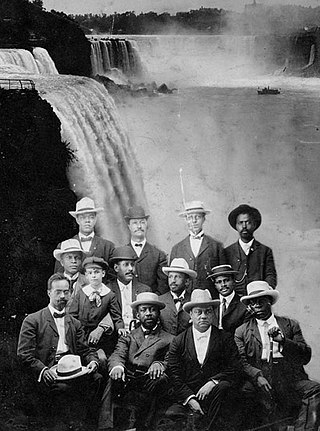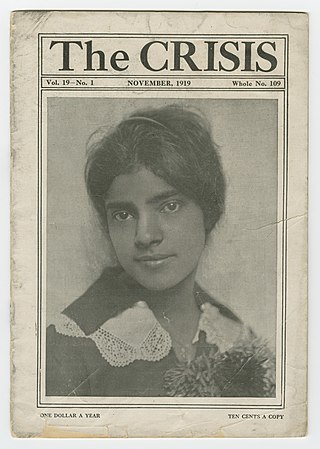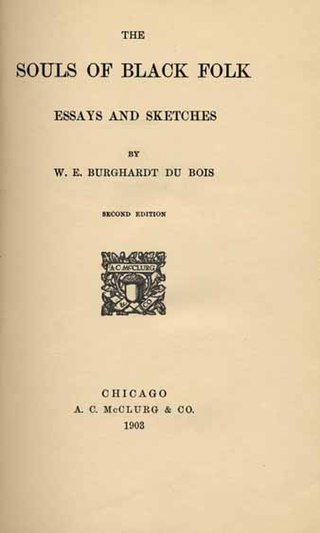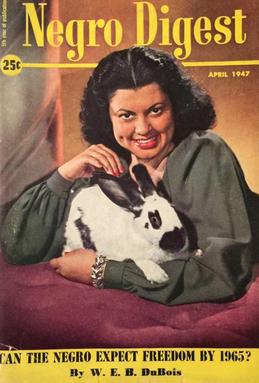
William Edward Burghardt Du Bois was an American sociologist, socialist, historian, and Pan-Africanist civil rights activist. Born in Great Barrington, Massachusetts, Du Bois grew up in a relatively tolerant and integrated community. After completing graduate work at the Friedrich Wilhelm University and Harvard University, where he was the first African American to earn a doctorate, he became a professor of history, sociology, and economics at Atlanta University. Du Bois was one of the founders of the National Association for the Advancement of Colored People (NAACP) in 1909.

The Niagara Movement (NM) was a black civil rights organization founded in 1905 by a group of activists—many of whom were among the vanguard of African-American lawyers in the United States—led by W. E. B. Du Bois and William Monroe Trotter. It was named for the "mighty current" of change the group wanted to effect and took Niagara Falls as its symbol. The group did not meet in Niagara Falls, New York, but planned its first conference for nearby Buffalo.

William Monroe Trotter, sometimes just Monroe Trotter, was a newspaper editor and real estate businessman based in Boston, Massachusetts. An activist for African-American civil rights, he was an early opponent of the accommodationist race policies of Booker T. Washington, and in 1901 founded the Boston Guardian, an independent African-American newspaper he used to express that opposition. Active in protest movements for civil rights throughout the 1900s and 1910s, he also revealed some of the differences within the African-American community. He contributed to the formation of the National Association for the Advancement of Colored People (NAACP).

The Crisis is the official magazine of the National Association for the Advancement of Colored People (NAACP). It was founded in 1910 by W. E. B. Du Bois (editor), Oswald Garrison Villard, J. Max Barber, Charles Edward Russell, Kelly Miller, William Stanley Braithwaite, and Mary Dunlop Maclean. The Crisis has been in continuous print since 1910, and it is the oldest Black-oriented magazine in the world. Today, The Crisis is "a quarterly journal of civil rights, history, politics and culture and seeks to educate and challenge its readers about issues that continue to plague African Americans and other communities of color."

Herbert Aptheker was an American Marxist historian and political activist. He wrote more than 50 books, mostly in the fields of African-American history and general U.S. history, most notably, American Negro Slave Revolts (1943), a classic in the field. He also compiled the 7-volume Documentary History of the Negro People (1951–1994). In addition, he compiled a wide variety of primary documents supporting study of African-American history. He was the literary executor for W. E. B. Du Bois.

Joel Elias Spingarn was an American educator, literary critic, civil rights activist, military intelligence officer, and horticulturalist.

The Souls of Black Folk: Essays and Sketches is a 1903 work of American literature by W. E. B. Du Bois. It is a seminal work in the history of sociology and a cornerstone of African-American literature.

Eugene Francis Provenzo Jr. is a professor in the Department of Teaching and Learning at the University of Miami. He became a full professor in 1985.
The Boston Guardian was an African-American newspaper, co-founded by William Monroe Trotter and George W. Forbes in 1901 in Boston and published until the 1950s.
The term color line was originally used as a reference to the racial segregation that existed in the United States after the abolition of slavery. An article by Frederick Douglass that was titled "The Color Line" was published in the North American Review in 1881. The phrase gained fame after W. E. B. Du Bois' repeated use of it in his 1903 book The Souls of Black Folk.

The National Association for the Advancement of Colored People (NAACP) is a civil rights organization in the United States, formed in 1909 as an interracial endeavor to advance justice for African Americans by a group including W. E. B. Du Bois, Mary White Ovington, Moorfield Storey, and Ida B. Wells. Over the years, leaders of the organization have included Thurgood Marshall and Roy Wilkins.

The Negro Digest, later renamed Black World, was a magazine for the African-American market. Founded in November 1942 by publisher John H. Johnson of Johnson Publishing Company, Negro Digest was first published locally in Chicago, Illinois. The magazine was similar to the Reader's Digest but aimed to cover positive stories about the African-American community. The Negro Digest ceased publication in 1951 but returned in 1961. In 1970, Negro Digest was renamed Black World and continued to appear until April 1976.

Augustus Granville Dill was born in Portsmouth, Ohio. His parents were John Dill and Elizabeth Jackson. He received his B.A. from Atlanta University in 1906, received a second B.A. from Harvard in 1908, and received his M.A. in 1909 from Harvard.

The Brownies' Book was the first magazine published for African-American children and youth. Its creation was mentioned in the yearly children's issue of The Crisis in October 1919. The first issue was published during the Harlem Renaissance in January 1920, with issues published monthly until December 1921. It is cited as an "important moment in literary history" for establishing black children's literature in the United States.
The Negro Problem is a collection of seven essays by prominent Black American writers, such as W. E. B. Du Bois and Paul Laurence Dunbar, edited by Booker T. Washington, and published in 1903. It covers law, education, disenfranchisement, and Black Americans' place in American society.

Lafayette M. Hershaw was a journalist, lawyer, and a clerk and law examiner for the General Land Office of the United States Department of the Interior. He was a key intellectual figure among African Americans in Atlanta in the 1880s and in Washington, D.C., from 1890 until his death. He was a leader of the intellectual social groups in the capital such as Bethel Literary and Historical Society and the Pen and Pencil Club. He was a strong supporter of W. E. B. Du Bois and was one of the thirteen organizers of the Niagara Movement, the forerunner to the NAACP. He was an officer of the D.C. Branch of the NAACP from its inception until 1928. He was also a founder of the Robert H. Terrell Law School and served as the school's president.

Freeman H. M. Murray was an intellectual, civil rights activist, and journalist in Washington D.C. and Alexandria, Virginia. He was active in promoting black home-ownership, opposing Jim Crow laws and lynching, and supporting positive representation of African Americans in public art. He was a founding member of the Niagara Movement and was an editor of its journal, the Horizon, along with W. E. B. Du Bois and Lafayette M. Hershaw. Alongside his other work, Murray was an important intellectual leader and wrote an influential book of art criticism. In this, Murray was one of the first historians of African American art. His work expressed a desire that art take seriously the representation of African Americans and that slavery not be overlooked in favor of representation of heroes and glory in public art.
George W. Forbes (1864-1927) was an American journalist who advocated for African-American civil rights in the late 19th and early 20th centuries. He is best known for co-founding the Boston Guardian, an African-American newspaper in which he and William Monroe Trotter published editorials excoriating Booker T. Washington for his accommodationist approach to race relations. He also founded and edited the Boston Courant, one of Boston's earliest black newspapers, and edited the A. M. E. Church Review, a national publication.

Martha Gruening (1889–1937) was an American-Jewish journalist, poet, suffragette, and civil rights activist, born in Philadelphia. Gruening was an early advocate for the intersectionality of gender, race, and class. Her writings and research for the NAACP led to the advancement of the civil rights movement and worked to include women of color in the fight for women's suffrage.
Racial uplift is a term within the African American community that motivates educated blacks to be responsible in the lifting of their race. This concept traced back to the late 1800s, introduced by black elites, such as W. E. B. Du Bois, Booker T. Washington, and African American musicians like Florence Price, who were significant contributors. During the beginnings of racial uplift, hymns and negro spirituals played a vital role in shaping the spiritual culture of African Americans. Although these musical selections are mainly prevalent inside the black church, contemporary gospel music has been utilized for the liberation and uplift of the oppressed black race. Aside from music, African American leaders have used concepts such as Du Bois's double consciousness that describe the idea of blackness and the complexities of identity in the various lens in which the black race envisions themselves in American society.














